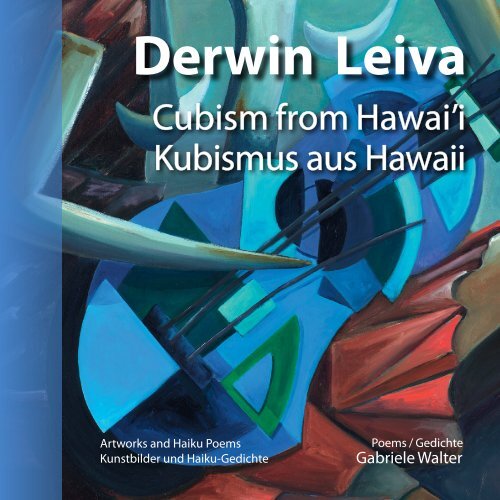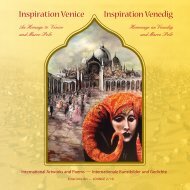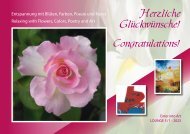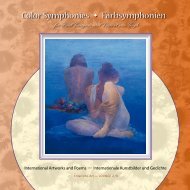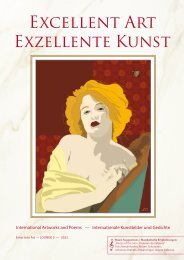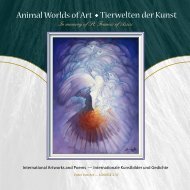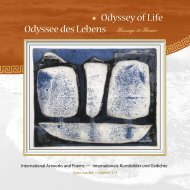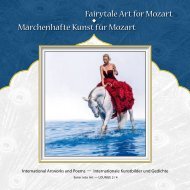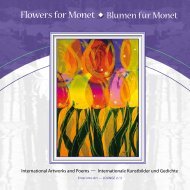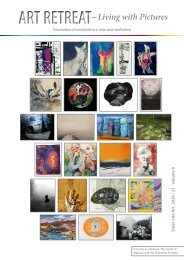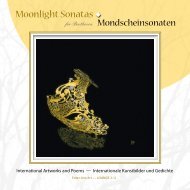Derwin Leiva - Cubism from Hawaii
Fiery sunsets, glowing lava rocks, and white sand beaches – that’s Hawai’i. Flowers bloom in radiant colors against the ocean’s blue. On his way to Cuba, Alexander von Humboldt analyzed the hues of the sky over exotic islands using a color scale, and found major differences compared to German skies. Inspired by this vibrant richness, in this solo book, the Cuban born artist Derwin Leiva presents a polychrome selection of paintings. Leiva pursued a bachelor’s degree in art with a focus on sculpture at the University of Hawai’i at Manoa. Since 2004, he has made Honolulu his home - the place where he lives and works. After growing up in the cultural environment of Caribbean cities, the artist now creates large oil paintings emanating a nostalgic melancholy. While the colorful temptations of Hawaiian folklore are also reflected in them, his Cubist-influenced paintings are dominated by voices of homesickness, wanderlust, and indeterminate longing. The printed book is available from bookseller Peecho in Amsterdam: https://www.peecho.com/checkout/162187384649059167/1298717/derwin-leiva-cubism-from-hawai-i-kubismus-aus-hawaii (Das gedruckte Buch ist beim Buchhändler Peecho in Amsterdam erhältlich.) Glühende Sonnenuntergänge, brodelndes Lavagestein und puderweiße Strände – das ist Hawai’i. Dazu schillert zum Blau des Meeres eine farbenreiche Blütenpracht. Alexander von Humboldt analysierte auf dem Weg nach Kuba das Himmelsblau exotischer Inselwelten anhand einer Farbskala und stellte starke Unterschiede zu deutschen Breitengraden fest. Angeregt von diesem Farbtriumph stellt der gebürtige Kubaner Derwin Leiva in seinem Solobuch eine polychrome Bildauswahl vor. Leiva erlangte an der University of Hawai’i Manoa einen Bachelor-Abschluss im Fach Kunst mit Schwerpunkt Bildhauerei. Seit 2004 hat er Honolulu zu seiner Heimat gemacht – dem Ort, wo er lebt und arbeitet. In den großformatigen Ölgemälden des im kulturellen Umfeld alter karibischer Städte aufgewachsenen Malers begegnet man einer nostalgischen Melancholie. Zwar spiegeln sich auch die farbenfroh-folkloristischen Verlockungen Hawai’is darin wider, begreiflicherweise dringen aus den kubistisch beeinflussten Bildern jedoch Töne von Heimweh, Fernweh und einer unbestimmbaren Sehnsucht.
Fiery sunsets, glowing lava rocks, and white sand beaches – that’s Hawai’i. Flowers bloom in radiant colors against the ocean’s blue. On his way to Cuba, Alexander von Humboldt analyzed the hues of the sky over exotic islands using a color scale, and found major differences compared to German skies. Inspired by this vibrant richness, in this solo book, the Cuban born artist Derwin Leiva presents a polychrome selection of paintings. Leiva pursued a bachelor’s degree in art with a focus on sculpture at the University of Hawai’i at Manoa. Since 2004, he has made Honolulu his home - the place where he lives and works. After growing up in the cultural environment of Caribbean cities, the artist now creates large oil paintings emanating a nostalgic melancholy. While the colorful temptations of Hawaiian folklore are also reflected in them, his Cubist-influenced paintings are dominated by voices of homesickness, wanderlust, and indeterminate longing.
The printed book is available from bookseller Peecho in Amsterdam:
https://www.peecho.com/checkout/162187384649059167/1298717/derwin-leiva-cubism-from-hawai-i-kubismus-aus-hawaii
(Das gedruckte Buch ist beim Buchhändler Peecho in Amsterdam erhältlich.)
Glühende Sonnenuntergänge, brodelndes Lavagestein und puderweiße Strände – das ist Hawai’i. Dazu schillert zum Blau des Meeres eine farbenreiche Blütenpracht. Alexander von Humboldt analysierte auf dem Weg nach Kuba das Himmelsblau exotischer Inselwelten anhand einer Farbskala und stellte starke Unterschiede zu deutschen Breitengraden fest. Angeregt von diesem Farbtriumph stellt der gebürtige Kubaner Derwin Leiva in seinem Solobuch eine polychrome Bildauswahl vor. Leiva erlangte an der University of Hawai’i Manoa einen Bachelor-Abschluss im Fach Kunst mit Schwerpunkt Bildhauerei. Seit 2004 hat er Honolulu zu seiner Heimat gemacht – dem Ort, wo er lebt und arbeitet. In den großformatigen Ölgemälden des im kulturellen Umfeld alter karibischer Städte aufgewachsenen Malers begegnet man einer nostalgischen Melancholie. Zwar spiegeln sich auch die farbenfroh-folkloristischen Verlockungen Hawai’is darin wider, begreiflicherweise dringen aus den kubistisch beeinflussten Bildern jedoch Töne von Heimweh, Fernweh und einer unbestimmbaren Sehnsucht.
Create successful ePaper yourself
Turn your PDF publications into a flip-book with our unique Google optimized e-Paper software.
<strong>Derwin</strong> <strong>Leiva</strong><br />
<strong>Cubism</strong> <strong>from</strong> Hawai’i<br />
Kubismus aus <strong>Hawaii</strong><br />
Artworks and Haiku Poems<br />
Kunstbilder und Haiku-Gedichte<br />
Poems / Gedichte<br />
Gabriele Walter
<strong>Derwin</strong> <strong>Leiva</strong><br />
<strong>Cubism</strong> <strong>from</strong> Hawai’i / Kubismus aus <strong>Hawaii</strong><br />
Artworks and Haiku Poems / Kunstbilder und Haiku-Gedichte<br />
Gabriele Walter (editor / Hrsg.)<br />
<strong>Cubism</strong> <strong>from</strong> Hawai’i<br />
Kubismus aus <strong>Hawaii</strong><br />
32 artworks by<br />
32 Kunstwerke von<br />
<strong>Derwin</strong> <strong>Leiva</strong><br />
25 haiku poems by<br />
25 Haiku-Gedichte von<br />
Gabriele Walter<br />
The Blue Guitar, 2018, oil on canvas, 152 x 122 cm, 60 x 48 in<br />
2 3
Detail: Cafe Metela<br />
Timbres of Wanderlust<br />
<strong>Cubism</strong> in Hawai’i? Wasn’t <strong>Cubism</strong> mostly associated<br />
with Paris, Picasso, Braque, and the French-German<br />
gallerist Kahnweiler? Yet <strong>Derwin</strong> <strong>Leiva</strong> found a<br />
natural affinity for painting in the Neo-Cubist style,<br />
particularly after being raised in Cuba, a rebellious<br />
island that once aimed to foster a unique kind of<br />
humanity, liberated <strong>from</strong> materialistic pursuits,<br />
and instead enriched by inner wealth. Columbus, on<br />
the other hand, hoped to find as much gold as possible<br />
there. Back then, only a few thousand native<br />
islanders survived. Later, within the short span of a<br />
hundred years, three quarters of a million Africans<br />
were brought to Cuba to toil on the sugar plantations.<br />
Besides their plaintive ballads, they also<br />
brought their sophisticated drumming rhythms and<br />
the odd fetish to the Caribbean. Havana became a<br />
major maritime trading hub with Latin America.<br />
Hawai’i, too, which became the fiftieth of the United<br />
States in 1959, is a melting pot of different peoples<br />
and cultures.<br />
As opposed to Picasso, <strong>Derwin</strong> <strong>Leiva</strong> has no<br />
need to visit anthropology museums. His personal<br />
history gives him all he needs to bring together<br />
the natural appeal and poetic immediacy of Latin<br />
America, African and Oceanic, as well as European<br />
art and culture. Through their brilliantly simplified<br />
shapes and sophisticated colors, the fetishes of<br />
indigenous peoples have long been a source of inspiration<br />
to modern artists (also see Wilfredo Lam,<br />
one of <strong>Leiva</strong>’s personal favorites). Today, the powerful<br />
expressiveness of art’s “primitive” beginnings is<br />
widely recognized. With their orgiastic shape and<br />
color compositions, they are in no way inferior to<br />
the “advanced civilizations” of today. We only need<br />
to look at hula dancers with their flower wreaths,<br />
chants, and grass skirts. <strong>Derwin</strong> <strong>Leiva</strong>’s art may also<br />
have been influenced by the colorful unique feather<br />
coats of former island kings. Indeed, his vibrant<br />
paintings are remindful of flamboyant ritual dances,<br />
the strongly stylized faces of his protagonists<br />
resemble masks. A hinted halfmoon stirs up associations<br />
of sun and moon mythology.<br />
Not only the culture but also the poetic-sounding<br />
language of the native <strong>Hawaii</strong>ans, who originally<br />
came <strong>from</strong> Polynesia, resembles the tongues<br />
of other South Sea islands. While it has 33 words<br />
for “clouds”, there is not a single one for “windless”<br />
– the music of the surf, the rippling waterfalls, the<br />
trade winds, and the heavy storms never cease. It<br />
is against this background that <strong>Derwin</strong> <strong>Leiva</strong> brings<br />
the dazzling colors and powerful music of Cuba and<br />
Hawai’i to his large oil paintings, and in this context<br />
that the editor contributes her haiku poetry. The<br />
artist's imagination was sparked by the sight of colibris<br />
frantically flapping their wings to find nectar<br />
amidst a plethora of flowers, by captivating coral<br />
reefs and colorful parrots, by the scent of tobacco,<br />
and by Cuba’s traditional folk dances and music, all<br />
of which stood out against its fading ideology.<br />
With the romantic architecture of his nostalgic<br />
places, the artist draws observers right into his<br />
images, appealing to all their senses at once. Picturesque<br />
colonnades, shady arcades, bumpy cobble<br />
stone roads, old tiled roofs and quaint wooden<br />
shutters, wrought-iron balconies and ornamental<br />
lattices, as well as walls in bright colors and playfully<br />
decorated homes tell us stories <strong>from</strong> the past<br />
two centuries of Latin American cities. Sometimes<br />
containing social commentary, the paintings bring<br />
together antiquated objects of daily life with quaint<br />
interiors painted in a Caribbean-influenced <strong>Hawaii</strong>an<br />
Neo-Cubist style. Through the visual swirl<br />
of colors and intentionally bent shapes, the artist<br />
makes his paintings dance. Observers can virtually<br />
feel his heart beating for the type of music known<br />
<strong>from</strong> Buena Vista Social Club, the classic Son Cubano,<br />
which, influenced by swing and jazz, brings<br />
together elements of both black and white music.<br />
At the same time, we can also hear the soft strumming<br />
of <strong>Hawaii</strong>an guitars. Sound and rhythm are<br />
the heartbeat that makes <strong>Derwin</strong> <strong>Leiva</strong>’s paintings<br />
come alive.<br />
Music-making is also featured in his works<br />
through the direct depiction of musicians and musical<br />
instruments, juxtaposed with lively old alleys.<br />
Multiple different shades of blue add to the music<br />
playing tones of sea and sky. Technically speaking,<br />
it is striking how contrasts in shape and color are<br />
brought together, while combining traditional<br />
techniques with elements of <strong>Cubism</strong> (breaking<br />
down objects, geometric, edgy, acute-angled and<br />
tube-like shapes), which makes <strong>Leiva</strong>’s original<br />
painting style the real object of his art. With his stereotyped<br />
dynamics of shapes and colors, the artist<br />
has created his very own highly unique and unmistakable<br />
style.<br />
4 5
Klangweisen des Fernwehs<br />
Kubismus auf Hawai’i? Wo doch der Begriff Kubismus<br />
vor allem an Paris, Picasso, Braque und<br />
den deutsch-französischen Galeristen Kahnweiler<br />
denken lässt? Und doch war es für <strong>Derwin</strong> <strong>Leiva</strong><br />
ein natürlicher Impuls, in neokubistischer Manier<br />
zu malen - umso mehr, da er seine Kindheit und<br />
Jugend auf Kuba verbracht hat - jener rebellischen<br />
Karibikinsel, auf der man einst einen neuen Menschen<br />
schaffen wollte – befreit von materiellem<br />
Ehrgeiz, erfüllt stattdessen von innerem Reichtum.<br />
Kolumbus hingegen hoffte, dort möglichst viel Gold<br />
zu finden. Damals überlebten nur einige Tausend<br />
Ureinwohner auf der Insel. Später wurden innerhalb<br />
von hundert Jahren eine dreiviertel Million<br />
Afrikaner nach Kuba gebracht, um auf den Zuckerplantagen<br />
zu schuften. Neben klagenden Balladen<br />
brachten sie ihre kunstvollen Trommelrhythmen<br />
und mancherlei Fetische in die Karibik. Havanna<br />
entwickelte sich zum Drehkreuz des Seehandels mit<br />
Lateinamerika. Auch Hawai’i, seit 1959 fünfzigster<br />
Bundesstaat der USA, ist ein Schmelztiegel verschiedener<br />
Völker und Kulturen.<br />
Im Gegensatz zu Picasso kann <strong>Derwin</strong> <strong>Leiva</strong> auf<br />
den Besuch völkerkundlicher Museen verzichten.<br />
Durch sein biografisches Umfeld besitzt er beste<br />
Voraussetzungen, um die Urwüchsigkeit und poetische<br />
Unmittelbarkeit lateinamerikanischer, afrikanischer<br />
und ozeanischer, wie auch europäischer<br />
Kunst und Kultur in sich zu vereinen. Durch ihre genial<br />
vereinfachten Formen und raffinierte Farbgebung<br />
sind auch die Fetische indigener Naturvölker<br />
dem Erfindungsreichtum moderner Künstler von<br />
jeher entgegengekommen (siehe u.a. <strong>Leiva</strong>s Vorbild<br />
Wifredo Lam). Die starke Ausdrucksfähigkeit<br />
der „primitiven“ Uranfänge der Kunst steht heute<br />
außer Zweifel. Mit ihren orgiastischen Farb- und<br />
Formkompositionen sind sie den Hochkulturen in<br />
keinster Weise unterlegen. Ein gutes Beispiel dafür<br />
sind die Blumenketten der Hula-Tänzerinnen mit<br />
ihren Sprechgesängen und samoanischen Grasröcken.<br />
Ebenso mag <strong>Derwin</strong> <strong>Leiva</strong>s Kunst vom vielfältigen<br />
Bunt der einzigartigen Federmäntel früherer<br />
Inselkönige beeinflusst sein. In der Tat erinnern seine<br />
bewegten Bilder an farbenfrohe Kulttänze und<br />
die stark vereinfachten Gesichter seiner Protagonisten<br />
an Masken. Allein durch einen Halbmond angedeutet,<br />
wecken sie Assoziationen an die Mythologie<br />
von Sonne und Mond.<br />
Außer Kultur und Natur ähnelt auch die Sprache<br />
der aus Polynesien stammenden Ureinwohner<br />
Hawai’is mit ihrem poetischen Klang den Sprachen<br />
anderer Südseeinseln. So besitzt sie über 33<br />
verschiedene Worte für „Wolken“, aber keines für<br />
„Windstille“ – ohne Unterlass ertönt die bewegte<br />
Musik von Brandung, rauschenden Wasserfällen,<br />
Passatwinden und starken Stürmen. Vor diesem<br />
Hintergrund lässt <strong>Derwin</strong> <strong>Leiva</strong> in seinen großformatigen<br />
Ölbildern die Farbenfreudigkeit und Melodik<br />
der Inselparadiese Kuba und Hawai’i erklingen.<br />
In diesem Rahmen fließt auch die Haiku-Poesie der<br />
Herausgeberin in das Buch ein. Die Fantasie des<br />
Malers wurde angeregt durch den Anblick rasant<br />
flatternder Kolibris auf Nektarsuche in einer verlockenden<br />
Blütenpracht, durch bezaubernde Korallenriffe<br />
und bunte Papageien, durch den Duft von<br />
Tabak, und durch Kubas folkloristische Tänze, die<br />
vor seiner verstaubten Ideologie besonders prächtig<br />
erschienen.<br />
Mit dem romantischen Baustil seiner nostalgischen<br />
Orte setzt der Künstler den Betrachter mitten<br />
ins Bild und spricht all seine Sinne an. Pittoreske<br />
Kolonnaden und schattige Arkaden, holpriges<br />
Steinpflaster, alte Ziegeldächer und urige Fensterläden<br />
aus Holz, schmiedeeiserne Balkone und<br />
Ziergitter sowie farbige Mauern mit verspieltem<br />
Hausschmuck erzählen Geschichten aus lateinamerikanischen<br />
Städten der letzten zwei Jahrhunderte.<br />
Teils mit sozialen Aussagen versehen, verbinden<br />
sich die Bildinhalte mit antiquierten Gegenständen<br />
des täglichen Lebens und einem idyllischen Interior,<br />
dargestellt in der Malweise eines hawaiischen<br />
Neokubismus karibischer Art. Durch den optischen<br />
Wirbel aus Farben und absichtlich gekrümmten Formen<br />
bringt der Künstler tänzerische Bewegung auf<br />
die Leinwand. Deutlich spürt man, dass sein Herz<br />
für die Musik eines Buena Vista Social Club, für den<br />
klassischen Son Cubano schlägt, welcher unter dem<br />
Einfluss von Swing und Jazz schwarze und weiße<br />
Elemente vereint. Aber auch die weichen Klänge<br />
der Hawai’i-Gitarre spielen mit hinein. Klang und<br />
Rhythmus sind die treibenden Elemente, die <strong>Derwin</strong><br />
<strong>Leiva</strong>s Bilder zum Pulsieren bringen.<br />
Das Musizieren als solches wird durch die Darstellung<br />
von Musikanten und Musikinstrumenten<br />
präsentiert und in Beziehung zu den lebhaften<br />
alten Gassen gebracht. Eine Vielfalt an Blautönen<br />
lässt zudem die Musik des Meeres und des Himmels<br />
mitklingen. Technisch treffen multiplizierende<br />
Formkontraste und Farbkontraste aufeinander.<br />
Dabei werden traditionelle Darstellungsweisen mit<br />
kubistischen Elementen (Zerlegung von Körpern,<br />
geometrisierende, spitzwinkelig kantige und röhrenartige<br />
Gebilde) kombiniert und machen <strong>Leiva</strong>s<br />
selbstentwickelte Kunstmittel zum eigentlichen<br />
Gegenstand der Malerei. Mit seiner stereotypen<br />
Farb- und Formendynamik hat der Künstler einen<br />
ganz eigenen, unverwechselbaren Stil erschaffen.<br />
6 Detail: Music For Two<br />
7
Nostalgia, 2018, oil on canvas, 152 x 122 cm, 60 x 48 in<br />
8 9
Die Feuerranke<br />
Im sonnendurchwobenen<br />
Schatten glutrot blüht.<br />
The flamevyne blooming<br />
In the sun-webbed shade glowing<br />
Like red lava cracks.<br />
Im Gefieder der<br />
Arapapageien ein<br />
Seeblau zum Träumen.<br />
There in the feathers<br />
Of the macaws a dazzling<br />
Dream of ocean blue.<br />
Das Arabeskenspiel<br />
Des Prachtfalters in der<br />
Korallenblume.<br />
The arabesque play<br />
Of the gorgeous butterfly<br />
In the coral tree.<br />
Hinter windigen<br />
Palmenwedeln weiß die Gischt<br />
Im Türkis sich wiegt.<br />
Behind the windy<br />
Fronds of palm trees the white surf<br />
Rocking in turquoise.<br />
Betörend gelb<br />
Herausgeputzt. Prachtfedern der<br />
Akanthusblüte.<br />
Arrayed in stunning<br />
Yellow, the feathers of the<br />
Acanthus flower.<br />
10 11
Art Meditation<br />
Imagine you are at an exhibition featuring these works,<br />
mindfully observing them. Close your eyes and observe<br />
your breath, or listen to it, until you feel pleasantly calm.<br />
Pick an artwork:<br />
• What is this artwork about? What is special about it?<br />
• Take your time and analyze the colors and shapes in<br />
this work. Feel their sound!<br />
• What spontaneous associations does this artwork trigger<br />
in you?<br />
• What would you say is “that certain something” about<br />
it - that mysterious aspect that is difficult put into<br />
words, and that has sprung directly <strong>from</strong> the artist’s<br />
soul?<br />
Kunstmeditation<br />
Stell dir vor, du würdest eine Ausstellung mit den Kunstwerken<br />
besuchen und sie in achtsamer Weise betrachten.<br />
Schließe deine Augen und beobachte bzw. höre deinen<br />
Atem so lange, bis du angenehme Ruhe in dir spürst und<br />
suche dir danach ein Kunstwerk aus:<br />
• Worum geht es in dem Kunstwerk? Welche Besonderheiten<br />
weist es auf?<br />
• Nimm dir Zeit und analysiere die Farben und die Formen!<br />
Spüre ihren Klang!<br />
• Welche Assoziationen weckt das Werk bei dir spontan?<br />
• Worin liegt das Geheimnisvolle, Unaussprechliche, das<br />
wohl rein aus der Seele quellende des Künstlers?<br />
12 Detail: The Cello Player<br />
13
Cafe <strong>Leiva</strong>, 2019, oil on canvas, 51 x 41 cm, 20 x 16 in<br />
The Singer, 2019, oil on canvas, 61 x 46 cm, 24 x 18 in<br />
14 15
A soul filled with the<br />
Light of old floras dreaming<br />
In golden alleys.<br />
Ein Geist voll Lustglanz<br />
Alter Floren verträumt sich<br />
Im Gold der Gassen.<br />
Cafe Metela, 2018, oil on canvas, 152 x 122 cm, 60 x 48 in<br />
16 17
Glittering games at<br />
The harbor, colorful nets,<br />
Spiraled balconies.<br />
Zum Glitzerspiel im<br />
Hafen bunte Netze und<br />
Schnörkelbalkone.<br />
Across The Bridge, 2020, oil on canvas, 152 x 122 cm, 60 x 48 in<br />
18 19
At golden hour,<br />
The bow of a violin<br />
Plays sea symphonies.<br />
Im Abendgold ein<br />
Violinbogen spielt des<br />
Meeres Symphonie.<br />
Lucky Shoes, 2022, oil on canvas, 76 x 31 cm, 30 x 24 in<br />
20 21
The Bath, 2021, oil on canvas, 152 x 122 cm, 60 x 48 in<br />
The Violinist, 2018, oil on canvas, 152 x 122 cm, 60 x 48 in<br />
22 23
Evening descends<br />
As dusk quietly weds the<br />
Glow of the lanterns.<br />
Abend sich senkt,<br />
Das Dämmerlicht sich mit dem<br />
Laternenschein vermählt.<br />
The Cello Player, 2018, oil on canvas, 152 x 122 cm, 60 x 48 in<br />
24 25
Café „La Terrasse“<br />
At the poet’s carousel<br />
Femme à la guitare.<br />
Café „La Terrasse“<br />
Beim Dichterkarussell spielt<br />
Femme à la guitare.<br />
Love Quest, 2019, oil on canvas, 61 x 46 cm, 24 x 18 in<br />
26 27
Its branches bending,<br />
Under the ripe load of fruit,<br />
The orange tree abides.<br />
Mit schweren Zweigen<br />
Der Orangenbaum trägt der<br />
Früchte schwüle Last.<br />
The Market, 2020, oil on canvas, 99 x 91 cm, 39 x 36 in<br />
28 29
The Celebration, 2017, oil on canvas, 274 x 427 cm, 108 x 168 in<br />
Music For Two, 2019, oil on canvas, 152 x 213 cm, 60 x 84 in<br />
30 31
Into the captain’s house,<br />
Up the steep stairs: balcony<br />
With harbor view.<br />
Im Kapitänshaus<br />
Die steile Treppe hinauf<br />
Hafenblickbalkon.<br />
The Living Room, 2020, oil on canvas, 152 x 122 cm, 60 x 48 in<br />
32 33
Onto my straw hat<br />
Tap-tap-a-taps the soft sound<br />
Of dripping laundry.<br />
Auf meinem Strohhut<br />
Das sanfte Tönen von den<br />
Wäschetropfen klingt.<br />
Amor De Balcones, 2019, oil on canvas, 91 x 76 cm, 36 x 30 in<br />
34 35
Life with all its pain<br />
And Melancholy, not a<br />
Gift to give away.<br />
Nicht verschenkend das<br />
Leben mit allem Leid und<br />
Der Melancholie.<br />
90 Miles, 2019, oil on canvas, 91 x 76 cm, 36 x 30 in<br />
36 37
La Cocina De Abuela, 2019, oil on canvas, 76 x 61 cm, 30 x 24 in<br />
La Costurera, 2019, oil on canvas, 76 x 61 cm, 30 x 24 in<br />
38 39
An old door at the<br />
End of the alleyway and<br />
The coo of pigeons.<br />
Eine alte Tür<br />
Am Ende der Gasse und<br />
Das Täubchengurren.<br />
Old NEWS, 2019, oil on canvas, 51 x 41 cm, 20 x 16 in<br />
40 41
The melancholy<br />
Of a lovesick happiness<br />
Fades into the night.<br />
Des kleinen Glückes<br />
Melancholie liebeskrank<br />
Des Nachts verhallend.<br />
La Vendedora de Flores, 2019, oil on canvas, 91 x 76 cm, 36 x 30 in<br />
42 43
Voices abuzz and<br />
A-chatter at the café.<br />
The cigarette glows.<br />
Zu den summenden<br />
Stimmen im Café glutrot<br />
Die Zigarre glimmt.<br />
Friendship, 2022, oil on canvas, 152 x 122 cm, 60 x 48 in<br />
44 45
La Pianista, 2019, oil on canvas, 91 x 76 cm, 36 x 30 in<br />
Social Distance, 2022, oil on canvas, 152 x 122 cm, 60 x 48 in<br />
46 47
On the colorful<br />
Facades, the silhouettes of<br />
Feather palms dancing.<br />
Bunte Hauswände<br />
Geschmückt mit Schattenbildern<br />
Der Fiederpalmen.<br />
The Carnival, 2016, oil on canvas, 122 x 107 cm, 48 x 42 in<br />
48 49
The colorful sound<br />
Of the mandolin by the<br />
Bamboo sweetly fades.<br />
Mandolinenton<br />
Dort am Bambus farbenreich<br />
Süß duftend ausklingt.<br />
The Color Of The Music, 2016, oil on canvas, 122 x 91,5 cm, 48 x 36 in<br />
50 51
Above the frenzy<br />
Of the city, the round moon.<br />
Its silence touching.<br />
Zum Taumel der Stadt<br />
Rührend in seiner Stummheit<br />
Der runde Mond thront.<br />
Musical Lust, 2017, oil on canvas, 152 x 122 cm, 60 x 48 in<br />
52 53
The Red Violin<br />
2016<br />
bronze<br />
61 x 18 x 6,5 cm, 24 x 7 x 2.5 in<br />
My Broken Guitar<br />
2016<br />
wrought iron, cast iron and copper<br />
81 x 46 x 7,5 cm, 32 x 18 x 3 in<br />
Fragmented Cello<br />
2016<br />
wrought iron<br />
107 x 35,5 x 6,5 cm, 42 x 14 x 2.5 in<br />
Musical Glass, 2017, glass - cold fabrication, 76 x 25,5 x 6,5 cm, 30 x 10 x 2.5 in<br />
54 55
The Hungry Musician, 2017, oil on canvas, 152 x 122 cm, 60 x 48 in<br />
56 57
Architektonische Farbwonnen<br />
Der kubanische Künstler <strong>Derwin</strong> <strong>Leiva</strong> hat auf der Trauminsel Hawai‘i seinen Weg in die progressive<br />
Kunstszene gefunden. Farblich suggestiv und wirkungsvoll in aufgesplitterten Formen präsentiert<br />
er rege und genial seinen markanten Stil. In tonigem Kolorit werden Details, Erhöhungen und<br />
Lichteffekte herausgearbeitet. Bei genügend Farb- und Sonnenpracht lässt sich der Künstler auch<br />
von abendlichen Bohème-Szenen mit Rotwein und Tanz inspirieren. Zu großen Teilen geometrisch<br />
aufgebaut und erweitert durch die dritte Dimension wirken seine Bilder duftig und locker. Den<br />
Architectoral Color Bliss<br />
plastisch erscheinenden Kompositionen liegen architektonische Ideen und eine vom Supremat<br />
des Gefühls geprägte Betrachtungsweise zugrunde.<br />
Cuban artist <strong>Derwin</strong> <strong>Leiva</strong> made his way into the progressive<br />
art scene on the heavenly islands of Hawai’i.<br />
einen spezifisch haiwai‘ianischen, zugleich jedoch<br />
Den klassischen Kubismus übersetzt der Künstler in<br />
Using suggestive colors and fragmented shapes, he presents<br />
his distinctive style with an unmistakable touch of<br />
stellt er Stadtansichten und musische Interieurs dar,<br />
sehr persönlichen Stil. In wiedererkennbarer Weise<br />
lively genius. In clay-like color tones, he brings out details,<br />
protrusions, and light effects. If the colors and the<br />
Objekte interessiert. Den Bildern des hochrangigen<br />
wobei er sich vor allem für die kubische Qualität der<br />
sunset are vibrant enough, the artist occasionally finds<br />
Koloristen und beschwingten Technikers wohnen<br />
inspiration in scenes of bohemian night life featuring<br />
glühende Farben und eine überbordende Formenfülle<br />
inne. Man spürt seine Freude am Malen und<br />
wine and dance. Mostly using geometric structures<br />
and incorporating the third dimension, his motifs come<br />
seine Liebe zur Musik, welche ihm einen geradezu<br />
out airy and laid back. His compositions have a threedimensional<br />
look about them arising <strong>from</strong> architectural<br />
unwiderstehlichen Schaffensdrang verleihen.<br />
ideas and a perspective embracing the supreme authority<br />
of feeling. While sticking to his own signature<br />
style, <strong>Leiva</strong> translates classical cubism into a distinctly<br />
Hawai’an version. He depicts recognizable city spaces and indoor musical performances with a special<br />
interest in the cubic qualities of their objects. With distinguished coloring and vivacious technical skills,<br />
<strong>Leiva</strong> imbues his work with radiant colors and an exuberant variety of shapes. Looking at them, one can<br />
literally feel his love of painting and music, and his irresistible urge to create.<br />
<strong>Derwin</strong> <strong>Leiva</strong><br />
https://www.derwinleiva.com/<br />
derwinleiva@gmail.com<br />
58 Detail: Cafe <strong>Leiva</strong><br />
59
Im weißen Sand der<br />
Palmen Meeresruh auf feinem<br />
Samt gebettet.<br />
The seaside resting<br />
Place of Palm trees: like velvet<br />
Their bed of white sand.<br />
Das Lavaschwarz von<br />
Goldglitzernden Körnchen des<br />
Sandwehens bestäubt.<br />
Glittering golden<br />
Grains of sand blown across black<br />
Lava by the wind.<br />
Segelmaste beim<br />
Sonnenuntergang schillern,<br />
Tanzen und klingen.<br />
The masts of sailboats<br />
Glistening as the sun sets,<br />
Dancing and singing.<br />
Über wallendem<br />
Gold der Mond erglänzt in<br />
Sternentrunkener Nacht.<br />
On undulating<br />
Gold, the moon makes an entrance<br />
In a star-drunk night.<br />
Im schaumwandelnden<br />
Träumen dämonisch versinkt<br />
Die Nacht im Meer.<br />
In foam-walking dream<br />
The night demonically<br />
Sinks into the sea.<br />
Detail: The Violinist<br />
60 61
<strong>Cubism</strong> <strong>from</strong> Hawai’i<br />
<strong>Derwin</strong> <strong>Leiva</strong><br />
Artworks by <strong>Derwin</strong> <strong>Leiva</strong><br />
Haiku poems by Gabriele Walter<br />
Imprint:<br />
Editor: Gabriele Walter<br />
Written by: Gabriele Walter<br />
Cover, illustrations, design by: Kurt Ries<br />
Translated into English by: Anna Sanner<br />
Copyright:<br />
Gabriele Walter<br />
Pützstücker Straße 45<br />
D-53639 Königswinter<br />
Tel. 0049 2244 3823<br />
www.enterintoart-books.com<br />
www.enter-into-art.com, www.meditaterra.de<br />
Kubismus aus <strong>Hawaii</strong><br />
<strong>Derwin</strong> <strong>Leiva</strong><br />
Kunstbilder von <strong>Derwin</strong> <strong>Leiva</strong><br />
Haiku-Gedichte von Gabriele Walter<br />
Impressum:<br />
Herausgeber: Gabriele Walter<br />
Text: Gabriele Walter<br />
Cover /künstlerische Gestaltung: Kurt Ries<br />
Übersetzung ins Englische: Anna Sanner<br />
Copyright:<br />
Gabriele Walter<br />
Pützstücker Straße 45<br />
D-53639 Königswinter<br />
Tel. 0049 2244 3823<br />
www.enterintoart-books.com<br />
www.enter-into-art.com, www.meditaterra.de<br />
Bibliography - Literaturnachweis:<br />
Bildkunst des 20. Jahrhunderts, Kubismus und Futurismus, Maly<br />
und Dietfried Gerhardus, Herder, Freiburg, Basel, Wien, 1977<br />
Kubismus, Guy Habasque, Skira, Geneve, 1959<br />
<strong>Hawaii</strong> sehen & erleben, Sammy Minkoff, Klaus Viedebantt,<br />
Südwest-Verlag, München, 1995<br />
Cuba, Tobias Hauser, Friedrich Köthe, Daniela Schetar, Bruckmanns<br />
Länderportraits, München, 2001<br />
Zauber vergangener Reiche, Wilhelm Zier, Deutscher<br />
Bücherbund, Stuttgart, 1975<br />
Vorgeschichte und Naturvölker, Schätze der Weltkunst, Berthelsmann-Verlag,<br />
Güthersloh, 1967<br />
Quote: https://www.widewalls.ch/magazine/picasso-quotes<br />
Bibliographic information of the German National Library:<br />
The German National Library lists this publication in the German National Bibliography; detailed bibliographic data are available<br />
on the Internet – http://dnb.ddb.de<br />
All rights reserved. Any reprinting in full or in part, any distribution by film, broadcasting, or television, any publication on the<br />
internet, or through photomechanical reproduction, sound recording, or data processing systems of any kind requires the<br />
written consent of the publisher.<br />
© Königswinter, 2023<br />
Bibliographische Information der Deutschen Bibliothek:<br />
Die Deutsche Bibliothek verzeichnet diese Publikation in der Deutschen Nationalbibliographie, detaillierte bibliographische<br />
Daten sind im Internet über http://dnb.ddb.de abrufbar.<br />
Alle Rechte vorbehalten. Nachdruck, auch auszugsweise, sowie die Verbreitung durch Film, Funk, Fernsehen und Internet,<br />
durch fotomechanische Wiedergabe, Tonträger und Datenverarbeitungssysteme jeglicher Art nur mit schriftlicher Genehmigung<br />
der Herausgeber.<br />
62 63
Fiery sunsets, glowing lava rocks, and white sand beaches – that’s<br />
Hawai’i. Flowers bloom in radiant colors against the ocean’s blue.<br />
On his way to Cuba, Alexander von Humboldt analyzed the hues of<br />
the sky over exotic islands using a color scale, and found major differences<br />
compared to German skies. Inspired by this vibrant richness, in this<br />
solo book, the Cuban born artist <strong>Derwin</strong> <strong>Leiva</strong> presents a polychrome<br />
selection of paintings. <strong>Leiva</strong> pursued a bachelor’s degree in art with a<br />
focus on sculpture at the University of Hawai’i at Manoa. Since 2004,<br />
he has made Honolulu his home - the place where he lives and works.<br />
After growing up in the cultural environment of Caribbean cities, the<br />
artist now creates large oil paintings emanating a<br />
nostalgic melancholy. While the colorful temptations<br />
of <strong>Hawaii</strong>an folklore are also reflected in them, his<br />
Cubist-influenced paintings are dominated by voices<br />
of homesickness, wanderlust, and indeterminate longing.<br />
Glühende Sonnenuntergänge, brodelndes<br />
Lavagestein und puderweiße Strände – das<br />
ist Hawai’i. Dazu schillert zum Blau des Meeres<br />
eine farbenreiche Blütenpracht. Alexander von<br />
Humboldt analysierte auf dem Weg nach Kuba das<br />
Himmelsblau exotischer Inselwelten anhand einer<br />
Farbskala und stellte starke Unterschiede zu deutschen<br />
Breitengraden fest. Angeregt von diesem Farbtriumph<br />
stellt der gebürtige Kubaner <strong>Derwin</strong> <strong>Leiva</strong> in seinem<br />
Solobuch eine polychrome Bildauswahl vor. <strong>Leiva</strong> erlangte<br />
an der University of Hawai’i Manoa einen Bachelor-Abschluss<br />
im Fach Kunst mit Schwerpunkt Bildhauerei.<br />
Seit 2004 hat er Honolulu zu seiner Heimat<br />
gemacht – dem Ort, wo er lebt und arbeitet. In den<br />
großformatigen Ölgemälden des im kulturellen Umfeld<br />
alter karibischer Städte aufgewachsenen Malers<br />
begegnet man einer nostalgischen Melancholie. Zwar<br />
spiegeln sich auch die farbenfroh-folkloristischen<br />
Verlockungen Hawai’is darin wider, begreiflicherweise<br />
dringen aus den kubistisch beeinflussten Bildern<br />
jedoch Töne von Heimweh, Fernweh und einer unbestimmbaren<br />
Sehnsucht.<br />
<strong>Derwin</strong> <strong>Leiva</strong> Poems / Gedichte: Gabriele Walter<br />
<strong>Cubism</strong> <strong>from</strong> Hawai’i - Kubismus aus <strong>Hawaii</strong><br />
64


